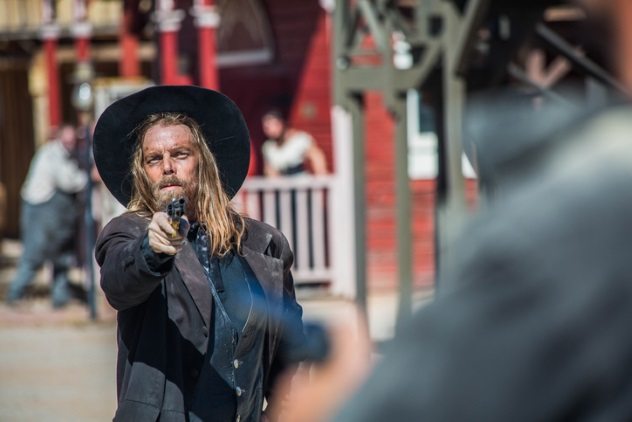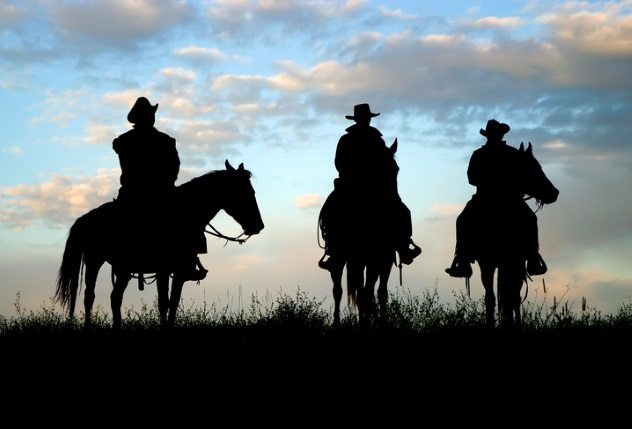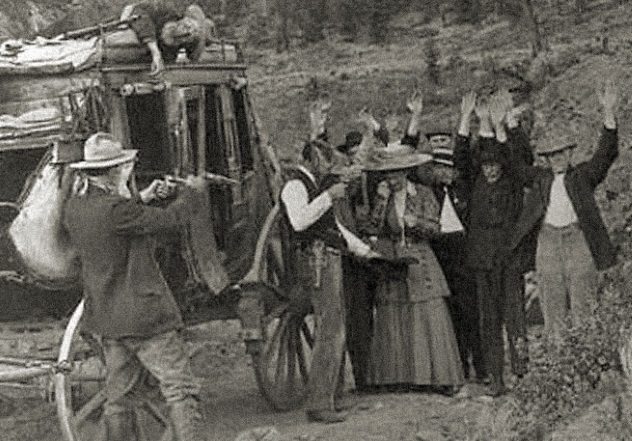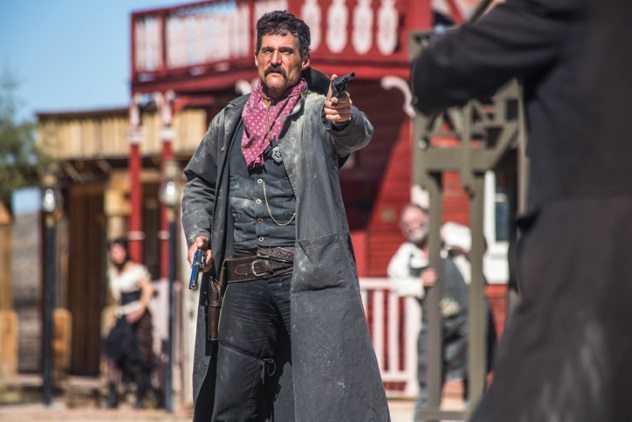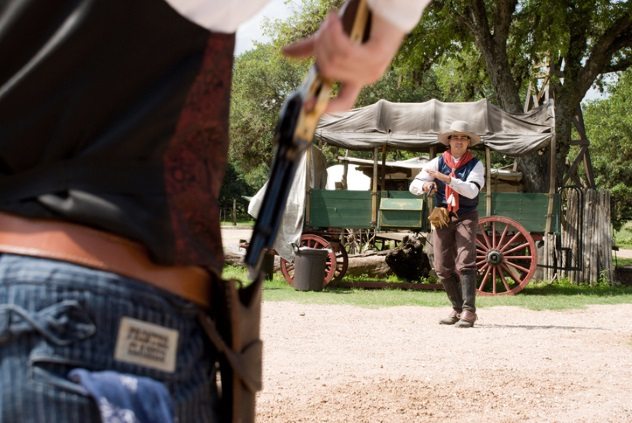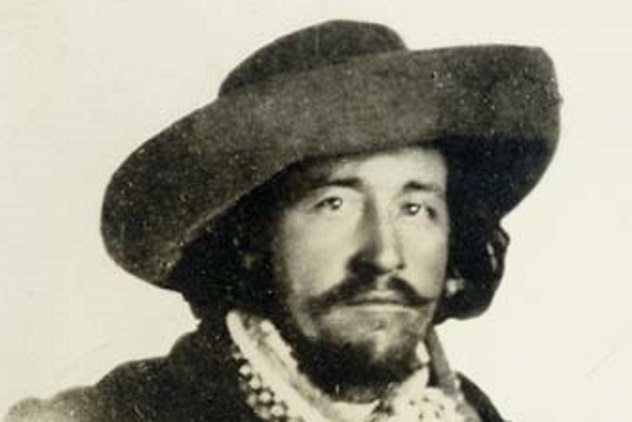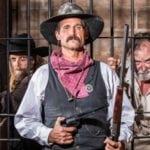But history doesn’t treat everyone equally. When some figures are pushed to the front, others are necessarily relegated to the background. These next entries are not well-remembered today, but their exploits formed a fascinating contribution to the lore of the Wild West.
10 The Rio Grande Posse
The Rio Grande Posse, active during the 1870s and 1880s, was also known as the John Kinney Gang after its founder and leader. Kinney, a military man, was discharged from the US Army in 1865 and started his gang, focusing primarily on cattle rustling and robbery. The gang contained members who would go on to become more prominent figures of the Wild West. They included Jesse Evans, who went on to form his own gang, and Charles “Pony Diehl” Ray, who later joined Curly Bill Brocius during his famous fights against the Earp brothers.[1] The Kinney Gang’s defining moment came in 1878, when it took part in the Lincoln County War, fighting against Billy the Kid and his Regulators. According to legend, Kinney got part of his ear shot off by Billy during a gunfight. When the feud was over, some of the men stayed with Kinney, while others broke off and joined Evans’s new gang. The end of the posse came in 1883, when Kinney was arrested for cattle rustling. By the time he was released, everyone else was either dead or in jail. Kinney avoided returning to a life of crime and instead joined the Army again during the Spanish-American War.
9 The Bummers
While most of the West’s infamous groups made a name for themselves through cattle rustling, robberies, and gunfights, the Colorado Territory was plagued by a less ambitious bunch. They were a group of lowlifes, losers, and layabouts known as the Bummers, headed by Eddie “Shooter” Coleman. They mostly targeted a mining settlement called Auraria, today a part of Denver. The Bummers usually resorted to petty theft and vandalism, taking advantage of the fact that the territory had not been incorporated yet and lacked any official law enforcement. At night, they would get loud, drunk, and rambunctious, firing their guns in the air as a display of intimidation toward the law-abiding citizens of the town. Eventually, the Bummers went too far. Over the Christmas holiday of 1859, the ne’er-do-wells stole a farmer’s wagon full of birds intended for Christmas dinners, triggering the colorfully named Turkey War.[2] The townsfolk had finally had enough and gathered a vigilante posse. The two groups clashed. One Bummer was killed during the fight, and a few more were promptly lynched. The rest of the gang got the message—they left town and went their separate ways.
8 The Innocents
The Innocents were either the most vicious, bloodthirsty gang in the history of the Old West or patsies who were used by an equally bloodthirsty group of vigilantes. It all depends on who you ask. First, the official version: The Innocents were a group of highwaymen active throughout the Montana Territory during the gold rush, preying on travelers carrying gold between cities. They were led by a corrupt sheriff named Henry Plummer and had killed over 100 people before they were stopped by a vigilante group. Most of the Innocents, sheriff included, wound up hanging from trees following brief trials or, in some cases, no trials at all. That was the official story for over a century, but historians in recent decades began to question if the Innocents were such a prolific gang or, indeed, if they existed at all. There are records of multiple gold robberies and murders during that time, but little evidence connects them together, let alone implicates one single gang. The dozens of alleged victims of the Innocents were cut into pieces and buried, burned, or dumped under ice, but none of them were found. Neither was their stolen treasure. The official story was believed for so long because it came from a reputable source. Many of the vigilantes became prominent figures of Montana’s early years as a state. This included Thomas Dimsdale, Montana’s first newspaper editor and the author of The Vigilantes of Montana.[3] People’s opinions of the Innocents were exemplified perfectly by Sheriff Henry Plummer’s posthumous trial in 1993. The verdict split 6-6, ending in a mistrial.
7 The Jennings Gang
The Jennings Gang was proof that, even in the Wild West, not everyone was cut out for a life of crime. Formed by lawyers-turned-criminals Al (pictured above) and Frank Jennings, the eponymous gang was initially feared because it also included former Wild Bunch member Richard “Little Dick” West. However, the gang’s short-lived criminal career only spanned a few months in 1897. Active in Oklahoma, they tried to rob a few trains, stores, and a post office, but none of their heists proved financially fruitful. One general store only had $15, and during one train robbery, they blew up an empty safe. Given their criminal incompetence, the gang was soon arrested. Only “Little Dick” managed to escape, and he died in a gunfight a year later. More interesting was Al Jennings’s career following his five-year stint in jail. After receiving a presidential pardon in 1907, Jennings got into politics and successfully won the Democratic nomination for Oklahoma County attorney in 1912. He ran on a platform of honesty, openly talking about his criminal past. While Jennings didn’t win, he attracted the attention of Hollywood and launched his fourth career as a silent film actor. His filmography included two dozen acting credits, including a starring role in a 1914 biopic about his life titled Beating Back. Jennings put his newfound popularity to good use and ran for governor Oklahoma. He finished third out of six in the Democratic primaries.[4]
6 The Red Jack Gang
The Red Jack Gang was active in the early 1880s, targeting stagecoaches along the San Pedro River in Arizona. The leader was “Red Jack” Almer, noted for his ginger hair and pale complexion, which gave him a youthful, almost feminine appearance. Although the gang pulled off several successful heists, their most memorable haul came on August 10, 1883, when they robbed a Florence-Globe Stagecoach carrying a Wells Fargo strongbox holding a fortune in gold. Prior to the robbery, Almer got on the stagecoach as a passenger to ensure it was transporting valuable loot. Conflicting reports say that he either got off before the robbery or stayed on and somehow signaled his partners. According to one colorful legend, Red Jack also took advantage of his appearance by wearing a dress and disguising himself as a woman to deflect suspicion.[5] Whatever the truth might be, the gang made off with thousands of dollars in gold, which was never recovered. However, their exploits also put the law on their trail, and several posses tracked them down one by one. Almer himself was killed in a gunfight by Earp associate Sheriff Bob Paul.
5 The Ketchum Gang
Tom “Black Jack” Ketchum (pictured above) started out his criminal career with his older brother, Sam, in the mid-1890s. The two were rumored to have been behind the 1896 disappearance and presumed murder of Texas senator Albert Fountain and his eight-year-old son, Henry. The brothers were involved in a bloody shootout that same year after robbing a store. The owner, Levi Herzstein, rounded up a small four-man posse and pursued the criminals. A gunfight ensued, in which Levi and a companion were killed, and the other two barely escaped with their lives.[6] As the Ketchum Gang grew, they began targeting trains and stagecoaches. By this point, the gang included several prominent outlaws who would go on to join Butch Cassidy’s Wild Bunch, such as Ben “Tall Texan” Kilpatrick and Harvey “Kid Curry” Logan. In 1899, the gang, led by Sam Ketchum, robbed a train without Tom. Although successful, they were pursued by a posse and engaged in a gunfight where several members were either killed or fatally injured, including Sam. Shortly thereafter, Black Jack tried to rob a train single-handedly. However, the conductor recognized him and blew off his right arm with a shotgun blast. Afterward, Ketchum was captured and arrested. The violent man met a fittingly violent end. His hanging was botched, and Ketchum was decapitated in front of a shocked audience.
4 The Dodge City Gang
Unlike other entries on this list, the Dodge City Gang had high aspirations and aimed to dominate the political and economic life of a booming Las Vegas, New Mexico, through corruption, intimidation, and violence. The gang was active for a few months in 1879. It was mostly composed of gunslingers who fought together during Railroad Wars in New Mexico. The leader was Hyman Neill, also known as Hoodoo Brown.[7] He parlayed his reputation as a gunfighter into a position as justice of the peace with the promise of stamping out corruption. Instead, he installed his fellow gunslingers into positions of law enforcement. Joe Carson, “Mysterious” Dave Mather, and Dave Rudabaugh became chief of police, deputy marshal, and policeman, respectively. Carson was soon killed in a shoot-out. Despite their successful positions, the gang members couldn’t refrain from the occasional robbery. Eventually, a deputy named John Sherman assembled enough honest men to catch the criminals in the act. Most of them were arrested. Mather was acquitted and went on to build a fearsome reputation as a gunfighter before vanishing from the history books. Although Hoodoo Brown didn’t take part in the robbery, the people knew he was involved, and an angry mob ran him out of town.
3 The Jack Taylor Gang
Active throughout the Arizona Territory and Mexico during the mid-1880s, the Jack Taylor Gang gained a fearsome reputation for being cruel and quick to draw. They once murdered four passengers during a single train robbery and four more train crew members on different occasions. The beginning of the end for the gang came in 1887, in Mexico, when the eponymous leader was captured by Rurales and sentenced to life in prison.[8] The rest of the gang returned to Arizona. However, this brought them under the purview of Cochise County sheriff “Texas” John Slaughter, who was tipped off to their presence, swiftly rounded up a posse, and went in pursuit. There were four members left: Manuel Robles, Fred Federico, Geronimo Miranda, and Nieves Deron. Foolishly, they thought they could hide out with relatives and visited Robles’ brother in Contention City. Slaughter learned of this and stormed the house where Deron and Robles were sleeping, prompting a gunfight. Deron was killed, and Robles, although shot, managed to escape and rendezvous with Miranda and Federico later. The men left Arizona and moved again into Mexican territory. All three remaining members of the Jack Taylor Gang met their end later that year. Robles and Miranda both died in a shootout with the Mexican Rurales. Federico shot a deputy sheriff and was captured and hanged soon after.
2 The McCanles Gang
The event that took place on July 21, 1861, at Rock Creek Station, Nebraska, became known as the McCanles Massacre. According to certain accounts, three men acted in self-defense against a ruthless gang looking to start trouble. Others, however, contend that the McCanles Gang never really existed and that those same three men committed cold-blooded murder to get out of a debt. Whatever the truth might be, the shootout helped start the legend of Wild Bill Hickok. David McCanles (pictured above) owned the property that the Rock Street Station was built on and where a then-unknown James Butler Hickok worked as a stock tender. According to the popular story, he was also a ruthless outlaw who terrorized the region with his gang. On that fateful day, McCanles and two of his men, James Woods and James Gordon, came to collect payment from the station manager, Horace Wellman. When the manager didn’t have the full sum, McCanles turned violent and tried to kill him. Luckily for Wellman, Hickok and another stock tender named Brink were present and jumped to his aid. In the ensuing shootout, McCanles and his two henchmen were gunned down. Hickok was later charged with murder but acquitted. There’s another version of the story, one told by McCanles’s 12-year-old son Monroe, who was there but wasn’t allowed to testify due to his age.[9] He claimed his father and his men came unarmed and were gunned down without provocation by Hickok, Wellman, and Brink. Wellman then tried to kill Monroe with a hoe but missed, and the boy managed to make a run for it.
1 The Reynolds Gang
The true nature of the Reynolds Gang is disputed, but few would argue against the fact that they had a fascinating history mostly forgotten today. They were Confederate soldiers who became outlaws, targeting the Colorado Territory. Led by Jim and John Reynolds, they primarily robbed coaches passing through the Kenosha Pass and weren’t above shedding blood from time to time. Some historians contend that the gang remained loyal to the Confederacy. They were under military orders to disrupt Union supply lines, and the stolen money was to be saved and sent back to the Confederate Army. Whatever the real story, people eventually had enough and formed a posse. They caught up to the gang on July 31, 1864, and a gunfight ensued. One outlaw died, and five others were captured shortly. Only John Reynolds and Jack Stowe managed to escape into New Mexico.[10] Afterward came another bit of controversy. The official story said that the prisoners were gunned down during a failed escape attempt. However, an inquiry by Confederate sympathizers revealed that the men were chained to a tree and executed under the orders of Colonel Chivington, the same man who orchestrated the Sand Creek Massacre. Fast-forward seven years, and John Reynolds was partnered with a man named Al Brown. After being fatally injured during a gunfight, Reynolds allegedly told Brown where he buried the money stolen with his gang. Brown traveled to Mount Logan but was unable to find the loot due to a landslide altering the landscape. Since then, treasure hunters have been eagerly searching the area, hoping to uncover Reynolds’s lost treasure.
